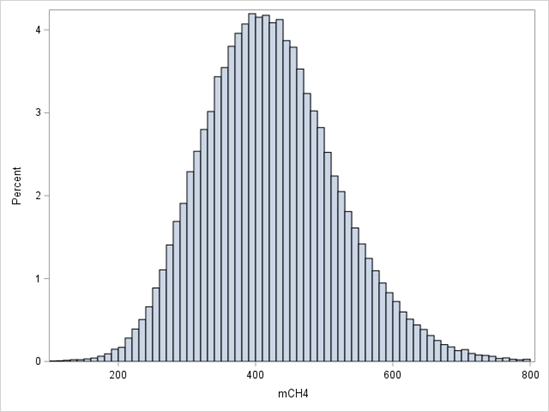
The aim of Geno’s green cow project is to include selection for improved feed efficiency and reduced methane emissions in the sustainable breeding goal for Norwegian Red. This to save feed costs and at the same time reduce environmental footprint from dairy production. Geno SA is the breeding organisation for Norwegian Red, the main dairy breed in Norway. The organisation is a cooperative owned by around 7,000 Norwegian dairy farmers.
Norwegian Red
The Norwegian Red is a high-yielding dairy breed www.norwegianred.com . The breeding program have strongly emphasised functional traits together with production traits since the 1970s. Compared to other dairy breeds Norwegian Red has put more emphasis on health traits over a longer time period. This balanced breeding goal has resulted in genetic improvement of production, health and fertility simultaneously. Genetic trends for Norwegian Red demonstrate that despite unfavourable genetic correlations between milk yield and health it is possible to obtain genetic improvement of both traits, if estimated breeding values are reliable and traits receive an appropriate weight in the total merit index used for selection. Reliable phenotypes is key to achieve this.
Data collection in commercial herds
To meet future challenges we should breed feed efficient cows and at the same time reduce environmental footprint from dairy production. Feed efficiency and methane emissions are challenging traits in dairy cattle, traits that are difficult, costly, time and labour intensive to collect. However, reliable phenotypes is crucial for success also when we want to include new traits in the breeding program. Geno has therefore established large scale phenotyping of Norwegian Red cows for these traits in collaboration with 14 commercial dairy herds. These are all herds with automatic milking systems, and all their cows are genotyped. Equipment to measure individual roughage intake https://biocontrol.no has been installed and GreenFeed www.c-lockinc.com units for measuring methane emissions are in place. The aim is to phenotype approximately 1,000 cows per year.
Methane emission in dairy cows
The first GreenFeed in this project was installed in 2019. The GreenFeed unit placed in the freestall barn offer a small amount of concentrate for motivation and the cows visit 2-5 times per day. Each visit provides an estimate of the cow’s methane emission (gram per day). Genetic analyses of methane emissions in Norwegian Red cows based on this data were presented by Wethal et al. (2022) and Heringstad et al. (2023). Figure 1 shows the phenotypic distribution form a dataset including 370,642 methane records from 814 cows. The mean was 422 gram methane per cow per day with a standard deviation of 96. One of the traits analysed was gram methane per cow per day, computed as the average of the cow’s individual visits each day. The estimated heritability (standard error) of this trait was 0.34 (0.04) (Heringstad et al., 2023). The predicted breeding values for cows with methane records ranged from -123 to 143, with standard errors between 22 and 34. This illustrates that there is genetic variation for the trait and breeding for lower methane emission is feasible.

Figure 1 . Distribution of phenotypic records of methane (CH4) emissions for Norwegian Red cows, measured as gram per cow per day from GreenFeed (from Heringstad et al., 2023)
Correlations between methane and other traits
We do not yet have enough data for estimation of genetic correlations between methane emissions and other traits. Correlation between predicted breeding values were therefore used to give an indication of strength and direction of genetic correlations between traits. The correlations between breeding values for methane and the cow’s official indexes for all traits in routine genetic evaluation varied between -0.24 and 0.25. Many of the correlations were close to zero. The highest positive correlations, i.e. high methane emission associated with good genetic merit for the other traits, were found to traits related to high milk production and large body size, while high genetic merit for health and fertility traits were associated with lower methane.
Methane emission in young bulls
Most of the research on methane emissions in dairy cattle have been on lactating cows, but there are also a few studies on young stock and bulls. Geno has one GreenFeed unit at their test station for young bulls and measure methane on all future Norwegian Red AI bulls.
In Norway around 100,000 Norwegian Red bull calves are born per year. Each year the 8,000 best are genotyped, and among these 150 bull calves are selected and brought to Geno’s test station when they are 3-4 month old. Around 50-60 of them will be selected to be AI bulls. Methane is measured the last month before they leave the station at 11-12 months age, and on average they have 40 days with methane measures.
Heringstad and Bakke (2023) presented a genetic analysis of methane emissions in young bulls including 212 Norwegian Red bulls. The average methane emission for these 11-12 month old bulls was 218 gram per bull per day. The estimated heritability was 0.56 when the trait analysed was gram methane per bull per day, computed as the average of the bull’s individual visits to the GreenFeed each day. The estimate was based on few animals and the standard error was therefore as expected relatively large (0.20). The predicted breeding values for bulls with methane records varied from -37 to +60, with standard errors ranging from 12 to 15.
Feed intake
The 14 herds have equipment to measure individual roughage intake. The feed bins from BioControl https://biocontrol.no/ record the amount of roughage or grass silage the cow eats at each visit. Together with data from concentrate feeding stations this provide detailed information on feed intake. Feed samples are collected by the farmers weekly and put in the freezer to make a representative monthly sample to be sent for analyses monthly. In the first genetic study of these data Bakke and Heringstad (2023) analysed total daily dry matter intake (DMI) form 557 cows with 61.321 records. Total DMI summarized DMI from roughage and concentrates, and the average was 20 kg per cow per day. The estimated heritability of total daily DMI was 0.18 (standard error 0.04).
The results we have so far show that we collect good data on feed intake from commercial herds, and that there is significant genetic variation for feed intake in Norwegian Red. It is still not clear what would be the best definition of feed efficiency for genetic evaluation of Norwegian Red, but feed intake and daily DMI are important parameters.
Results so far
Large scale phenotyping of methane and feed intake in commercial herds is established. Results so far indicate that there is substantial genetic variation for methane emission, roughage intake and total dry matter intake in the Norwegian Red breed, and breeding for these traits is feasible.
This project builds reference population for genomic evaluations and the growing database of reliable high-quality phenotypes of key parameters makes it possible to increase knowledge and develop the tools needed for successful implementation of breeding for improved feed efficiency and reduced methane emissions in Norwegian Red.
We aim to balance feed efficiency, climate effects, production, health, and fertility in a sustainable breeding goal for Norwegian Red.
Acknowledgements
Acknowledgements to all the participating herds for providing data and the Norwegian Research Fund for Agriculture and Food Industry (FFL/JA) for funding the research projects. The work presented here is done together with Dr. Karoline Bakke, researcher, Geno R&D, and Eli Hveem Krogsti, project leader of the feed efficiency project, Geno R&D.
References
Bakke, K.A. and B. Heringstad. 2023 Breeding values for daily dry matter intake in Norwegian Red dairy cows and correlation to other traits. Interbull Bulletin 59, 89-94. https://journal.interbull.org/index.php/ib/issue/view/70/Interbull_Bulletin_no59_2023
Heringstad, B. and K.A. Bakke. 2023. Heritability of methane emission in young Norwegian Red bulls estimated from GreenFeed measures at the test station. Interbull Bulletin 59, 69-73. https://journal.interbull.org/index.php/ib/issue/view/70/Interbull_Bulletin_no59_2023
Heringstad, B., K.A. Bakke, and G. Difford. 2023. Heritability of methane emission in dairy cows estimated from GreenFeed measures in commercial herds. 74th Annual meeting of EAAP, Lyon, France. Book of abstracts page 279.
Wethal, K.B., Difford, G.F., Winnberg, K., Norberg, E. and Heringstad, B. 2022. Heritability of methane emission in Norwegian Red cows based on measures from GreenFeed in commercial herds. Proceedings, 12th WCGALP. https://doi.org/10.3920/978-90-8686-940-4_32